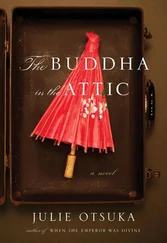CHAPTER FIFTEEN. In the Tuileries
THAT SPRING, when he was not in class or tending Polaner or seeing Klara, Andras learned the design and construction of stage sets under the tutelage of Vincent Forestier. Monsieur Forestier had a studio on the rue des Gravilliers where he drafted designs and built his models; for months he had been desperately in need of a new apprentice to assist with the copying of plans, the detailed and painstaking work of model construction. Forestier was tall and heavy and mournful, with a perpetual haze of gray stubble and a habit of punctuating his utterances with shrugs of his broad shoulders, as if he himself didn’t set much store by what he was saying. It turned out that he was also a quiet genius of design. With the strictest of financial constraints and the shortest of production times, he could produce palaces and city streets and shady glens in his own incomparable style. His stage sets often metamorphosed into one another: A fairy queen’s bower might become a commandant’s office in another theater on the other side of town, and then might serve a third tour of duty as a train compartment or a hermit’s hut or a pasha’s veil-draped bed. Andras’s idea of making flats with interiors on one side and exteriors on the other was one of Forestier’s lesser tricks. He made stage sets like puzzles, stage sets that could become three or four different interiors depending upon the order in which their panels were arranged; he was a master of optical illusion. He could make an actor seem to grow or shrink as he walked across a stage, could use a subtle shift of lighting to turn a nursery into a hall of horrors. Projections of hand-colored slides could suggest distant cities or mountains, ghostly presences, memories from a character’s youth. A magic lantern made to spin by the heat of a candle could send flocks of birds rippling across a scrim. Any stage set might conceal trapdoors and rotating panels; every surface hid a mysterious interior that might hide another interior that might hide still another interior that bore a haunting resemblance to the exterior. Monsieur Forestier himself had a way of appearing and disappearing as if he were an actor within a set he’d designed; he would come in and assign Andras a task, and five minutes later he would have vanished as if into a wall, leaving Andras to puzzle through the difficulties of the design alone. After the tumult of the Sarah-Bernhardt, Andras found it solitary and at times lonely work. But at night, when he came home to his room, Klara might be waiting.
He rushed home every night hoping she’d be there; most often it was her ghost he embraced in the dark, the shadow presence that remained in his room when the real Klara was absent. It nearly drove him mad when days would pass between her visits. He knew, but didn’t want to be reminded, that while he was going to school and working and taking care of Polaner, Klara was conducting her own life. She gave dinner parties, went to the cinema and the theater, to jazz clubs and gallery openings. He conjured images of the people she met at her friends’ parties or entertained at her own-choreographers and dancers from abroad, young composers, writers, actors, wealthy patrons of the arts-and felt certain that her attention would turn away from him. If for three nights she failed to appear at the rue des Écoles, he would think, Well, it’s happened, and spend the next day in a haze of despair. If he walked out alone he resented every couple he passed on the street; if he tried to distract himself with a film he cursed the jet-haired screen goddess who crept from her husband’s train compartment to climb into her lover’s moonlit couchette. If, at the end of such a night, he came home to the rue des Écoles to find a light on in his windows, he would climb the stairs telling himself she had only come to break it off for good. Then he’d open the door and find her sitting beside the fire, reading a novel or stitching the hem of a practice dress or making tea, and she would get to her feet and put her arms around his neck, and he would be ashamed he’d doubted her.
In mid-May, when the trees wore close-fitting green singlets and the breeze from the Seine was warm even at night, Klara appeared one Saturday evening in a new spring hat, a pale blue toque with a ribbon of darker blue. A new hat, that simple thing: It was nothing more than a scrap of fashion, a sign of the changing season. Surely she’d worn a variety of hats since the red bell of their first winter embraces; he could remember a camel-colored one with a black feather, and a green cap with some sort of leather tassel. But this decidedly vernal hat, this pale blue toque, reminded him, as the others hadn’t, that time was passing for both of them, that he was still in school and she was still waiting for him, that what existed between them was an affair, gossamer and impermanent. He removed her dragonfly hatpin and hung the hat on the coat stand beside the door, then took both her hands and led her to the bed. She smiled and put her arms around him, saying his name into his ear, but he took her hands again and sat down with her.
“What is it?” she said. “What’s wrong?”
He couldn’t speak, couldn’t begin to say what had made him melancholy. He couldn’t find a way to tell her that her hat had reminded him that life was short and that he was no closer to being worthy of her than he’d ever been. So he took her into his arms and made love to her, and told himself he didn’t care if there were never anything more between them than these late-night meetings, this circumscribed affair.
The hours passed quickly; by the time they’d pried themselves from the warmth of the bed and dressed, it was nearly three o’clock. They descended the five flights of stairs to the street, then walked to the boulevard Saint-Michel to hail a cab. They always said their goodbyes on the same corner. He’d grown to hate that patch of pavement for taking her away from him night after night. During the day, when its power to strip him of her was cloaked beneath the love-ignoring clamor of everyday life, it seemed a different place; he could almost believe it was like any other street corner, a place of no particular significance. But now, at night, it was his nemesis. He didn’t want to see it-not the bookstore across the street, nor the fenced limes, nor the pharmacy with its glowing green cross: none of it. He turned with her instead down another street and they walked toward the Seine.
“Where are we going?” she said, smiling up at him.
“I’m walking you home.”
“All right,” she said. “It’s a beautiful night.” And it was. A May breeze came up the channel of the Seine as they crossed the bridges toward the Marais. The sidewalks were still full of men and women in evening clothes; no one seemed ready to give up the night. As they walked, Andras entertained the impossible fantasy that when they reached Klara’s house they would climb the stairs together and move noiselessly down the hall to her bedroom, where they would fall asleep together in her white bed. But at Number 39 they found the lights ablaze; Mrs. Apfel ran downstairs at the sound of Klara’s key and told her that Elisabet had not yet been home.
Klara’s eyes widened with panic. “It’s past three!”
“I know,” Mrs. Apfel said, twisting her apron. “I didn’t know where to find you.”
“Oh, God, what could have happened? She’s never been this late.”
“I’ve been all over the neighborhood looking for her, Madame.”
“And I’ve been out all this time! Oh, God. Three in the morning! She said she was just going to a dance with Marthe!”
A panicked hour followed, during which Klara made a series of telephone calls and learned that Marthe hadn’t seen Elisabet all night, that the hospitals had admitted no one by the name of Elisabet Morgenstern, and that the police had received no report of foul play involving a girl of Elisabet’s description. When she’d hung up the phone, Klara walked up and down the parlor, her hands on her head. “I’ll kill her,” she said, and then burst into tears. “Where is she? It’s nearly four o’ clock!”
Читать дальше












